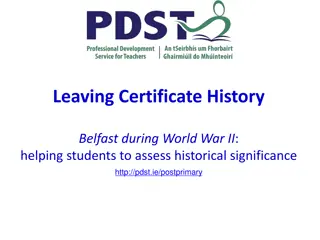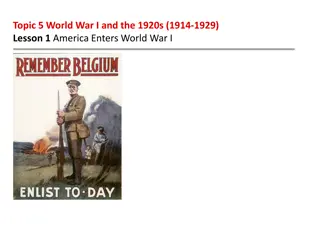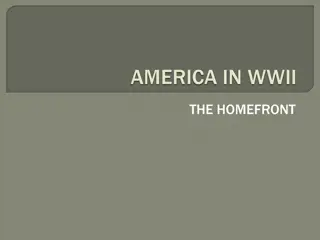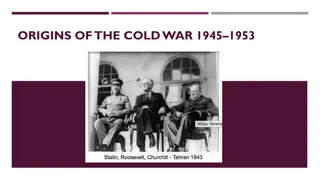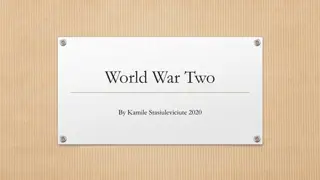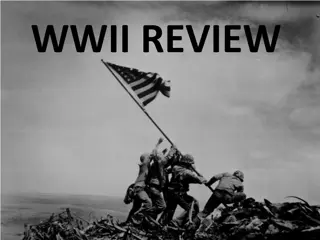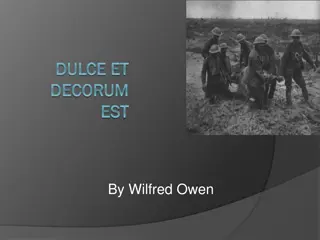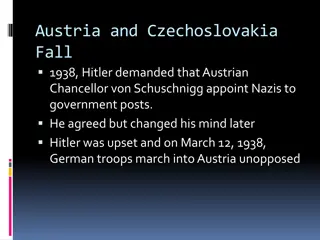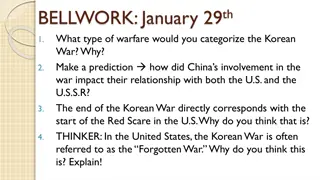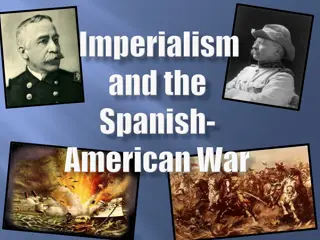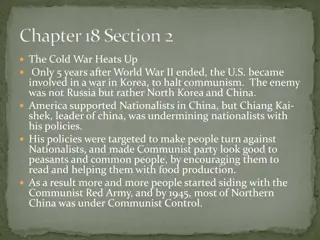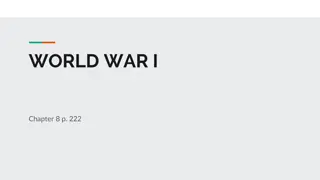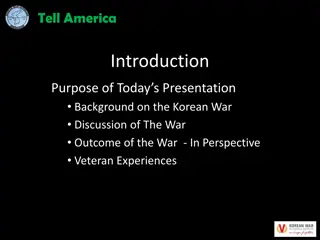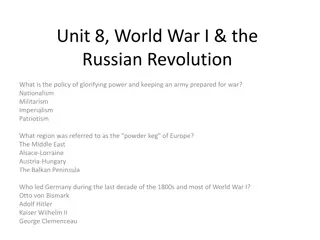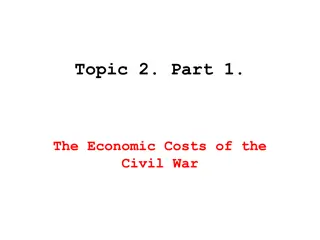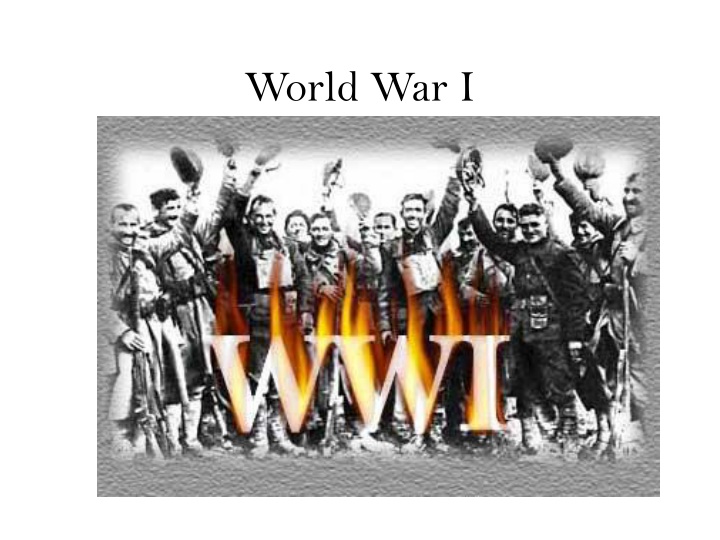
The Inevitability of World War I and Illusions of 1914-1915
Explore the chain of events leading to World War I starting from the assassination of Archduke Francis Ferdinand to the declaration of war by various countries. Delve into the misconceptions and illusions held by many Europeans about the war's duration and nature, ultimately leading to a global conflict with devastating consequences.
Download Presentation

Please find below an Image/Link to download the presentation.
The content on the website is provided AS IS for your information and personal use only. It may not be sold, licensed, or shared on other websites without obtaining consent from the author. If you encounter any issues during the download, it is possible that the publisher has removed the file from their server.
You are allowed to download the files provided on this website for personal or commercial use, subject to the condition that they are used lawfully. All files are the property of their respective owners.
The content on the website is provided AS IS for your information and personal use only. It may not be sold, licensed, or shared on other websites without obtaining consent from the author.
E N D
Presentation Transcript
Inevitability of war June 28, 1914 Archduke Francis Ferdinand of Austria assassinated July 5, 1914 Germany issues A-H blank check pledging military assistance if A-H goes to war against Russia July 23, 1914 Austria issues Serbia an ultimatum
The inevitability of war July 28, 1914 A-H declares war on Serbia July 29, 1914 Russia orders full mobilization of its troops August 1,1914 Germany declares war on Russia August 2, 1914 Germany demands Belgium declare access to German troops
Belgium is a country, not a road King Albert I of Belgium denied permission August 2, 1914 Germany declared war on France Why??? The Schlieffen Plan! August 4, 1914 Great Britain declared war on Germany for violating Belgian neutrality
1914 1915 Illusions and Stalemate Many Europeans were excited about war Defend yourself against the aggressors Domestic differences were put aside
1914 1915 Illusions and Stalemate War would be over in a few weeks Ignored the length and brutality of the American Civil War (prototype to World War I)
1914 1915 Illusions and Stalemate Belief that Modern industrial war could not be conducted for more than a few months Home by Christmas
1914 1915 Illusions and Stalemate Fatal attraction of war Exhilarating release from every day life A glorious adventure War would rid the nations of selfishness Spark a national re- birth based on heroism
The Schlieffen Plans Destructive Nature
The Schlieffen Plan Invade western front 1st After defeating France concentrate on the Eastern front Avoid fighting a 2 front war
The Schlieffen Plans Destructive Nature Germany made vast encircling movement through Belgium to enter Paris Underestimated speed of the British mobilization Quickly sent troops to France
The Schlieffen Plans Destructive Nature Sept 6-10, 1914 Battle of Marne Stopped the Germans but French troops were exhausted Both sides dug trenches for shelter STALEMATE
The Trenches Trenches dug from English Channel to Switzerland 6,250 miles 6 to 8 feet deep Immobilized both sides for 4 years
Life in the Trenches Elaborate systems of defense barbed wire Concrete machine gun nests Mortar batteries Troops lived in holes underground
Life in the Trenches Boredom Soldiers read to pass the time Sarah Bernhardt came out to the front to read poetry to the soldiers
Death is everywhere We all had on us the stench of dead bodies. Death numbed the soldier s minds. Shell shock Psychological devastation
Death is everywhere Mustard gas Carried by the wind Burned out soldier s lungs Deadly in the trenches where it would sit at the bottom
Life in the Trenches Trench warfare baffled military leaders Attempt a breakthrough Then return to a war of movement Millions of young men sacrificed attempting the breakthrough
Battle of Verdun 10 months 700,000 men killed
Battle of Verdun 10 months 700,000 men killed
The changes of war New weapons crippled the frozen front Poison gas (mustard gas) Hand grenades Flame throwers Tanks Airplanes Tanks Subs
The changes of war Airplanes Dog fights in the air Bombing inaccurate Romanticized the battlefields Paris and London bombed Pilots fired pistols and threw hand grenades
The Eastern Front Russian army moved into Eastern Germany on August 30, 1914 Defeated The Austrians kicked out of Serbia Italians attacked Austria in 1915 G. came to Austrian aid and pushed Russians back 300 miles into own territory
The Eastern Front Much more mobile more than the West But loss of life still very high 1915: 2.5 million Russians killed, captured, or wounded
The Eastern Front Germany and Austria Hungary joined by Bulgaria in Sept. 1915 Attacked and eliminated Serbia from war
The Home Front Women took war factory jobs Received lower wages than males Food shortages made running a household difficult
The Home Front Censorship Not told about high death toll Romanticized the battlefields soldiers have died a beautiful death, in noble battle, we shall rediscover poetry epic and chivalrous
The Home Front Censorship Newspapers described troops as itching to go over the top. Government reported to the press that life in the trenches promoted good health and clear air
The Home Front On Leave Troops would stay together so they could sympathize with each other
The Home Front Impossible to hide death Women in mourning Badly wounded soldiers returned home Opposition began to emerge
The war ends 1917 Russia surrenders (a separate peace) U.S. joins the war on the Allied side Nov. 11, 1918 Armistice
Death Toll of War Allied Powers Central Powers 42 million served 23 million served 22 million casualties 15 million casualties
Social Impact Men lost limbs and were mutilated Birthrate fell markedly Invalids unable to work Ethnic hostility Influenza epidemic
Psychological impact Never such innocence again Bitterness towards aristocratic officers whose lives were never in danger
This powerpoint was kindly donated to www.worldofteaching.com http://www.worldofteaching.com is home to over a thousand powerpoints submitted by teachers. This is a completely free site and requires no registration. Please visit and I hope it will help in your teaching.

![❤[PDF]⚡ Civil War Talks: Further Reminiscences of George S. Bernard and His Fel](/thumb/20551/pdf-civil-war-talks-further-reminiscences-of-george-s-bernard-and-his-fel.jpg)
